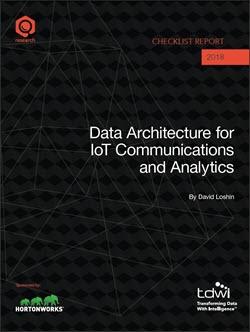
TDWI Checklist Report | Data Architecture for IoT Communications and Analytics
March 30, 2018
The Internet of Things (IoT) is an architectural paradigm that combines physical devices, massive network connectivity, data accumulation and analysis, and operational control informed by analytics models that enhance and optimize cross-system interoperation.
Integrated IoT analytics can help factories reduce or eliminate unscheduled downtime through predictive maintenance, enable manufacturers to improve production quality through continuous monitoring of assembly lines, and anticipate and consequently eliminate power outages across an energy utility’s regions by monitoring power usage across a broad network of smart meters. IoT analytics can even alert people to potential health risks by monitoring wearable fitness monitors.
The foundation of a successful IoT implementation is a technical architecture that blends network connectivity with an information architecture for streaming, ingesting, filtering, and capturing data.
This checklist explores some fundamental aspects of the data architecture necessary for IoT success. It examines what is required to rapidly adapt to massive numbers of connected sensors and other end-point devices, as well as deployment of developed analytics models for automated decision making.